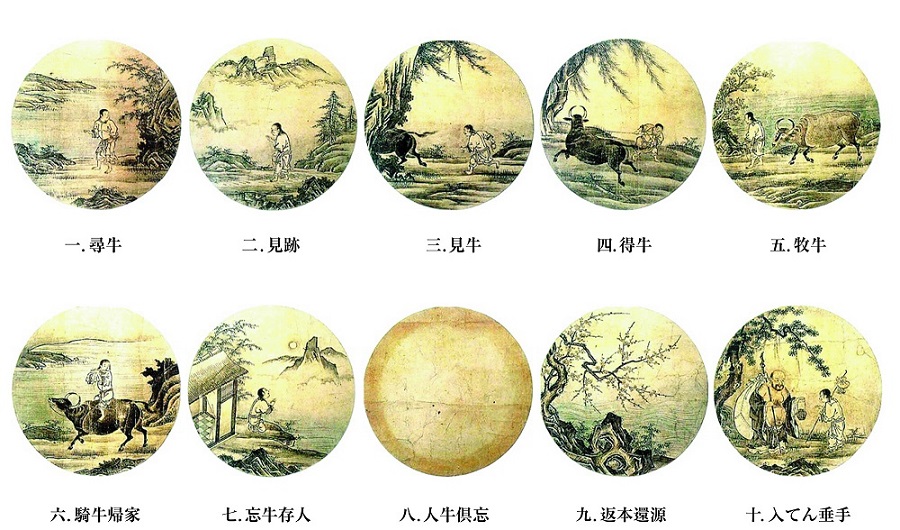[two_third]
Sthita Prajna (Stable Wisdom)
The real teachings of the Gita begin in Chapter 2, and the final 18 verses provide a succinct summary of the nature of awakened living. Arjuna asks Krishna about how a wise man lives, how he moves, talks, etc. Krishna, responds to the spirit of the question, that is, how does a man wise man, one who knows the ‘truth’ of himself, live in the world? How can anyone tell if he is wise or not? Krishna goes on to describe the nature of desire, the need for contemplation, the role the senses, the difference between ignorance and knowledge. It will take 16 more chapters to unfold this teaching completely, but this is a great way to start.
Chapter 2, verse 54
arjuna uvaaca:
sthitaprajnasya kaa bhaasaa samaadhisthasya keshava
sthitadhia kim prabhaaseta kimaasita vrajeta kim
Arjuna said: Oh Keshava (Krishna), what is the description of a person of firm wisdom, one who’s mind abides in the aatmaa, self? How does such a person, whose mind is not shaken by anything, speak, sit, walk?
Chapter 2, verse 55
srii bhagavaan uvaaca:
prajahaati yadaa kaamaan sarvaan paartha manogataan
atmanyevaatmanaa tushtah sthita prajna stadocyate
Sri Bhagavan said: when a person gives up all the desires as they appear in the mind, O Arjuna, happy in oneself, with oneself alone, that person is said to be one of stable wisdom.
Chapter 2, verse 56
duhkhesvanudvignamanahaah sukhesu vigatasprhah
vitaraagabhayakrodhah sthitadhirmunirucyate
The one who is not affected by adversities, who is without yearning for pleasures, who is free from longing, fear and anger, is said to be a wise person whose knowledge remains stable.
Chapter 2, verse 57
yah sarvatraanabhisnehastattatpraapya shubhaashubham
nabhinandhati na dvesti tasya prajnaa pratisthitaa
For one who is unattached in all situations, who neither rejoices on gaining the pleasant, nor hates the unpleasant, his knowledge is well established
Chapter 2, verse 58
yadaa samharate caayam kuurmo’ nganiiva sarvashah
indriyaanindriyaarthebhyastasya prajnaa pratisthitaa
And when, like the turtle that withdraws its limbs, this person is able to completely withdraw the sense organs from their objects, his knowledge is steady.
Chapter 2, verse 59
visayaa vinivartante niraahaarasya dehinah
rasavarjam raso’pyasyaparam drstvaa nivartate
For one who does not feed the senses, the senses come back to oneself, leaving the longing behind. Having seen Brahman (when the self is known), even the longing goes away.
Chapter 2, verse 60
yatato hyapi kaunteya purusasya vipascitah
indriyaani pramaathiini haranti prasabham manah
Because, the powerful senses of even the person who makes effort, who sees clearly, forcefully takes the mind away, Oh! Arjuna
Chapter 2, verse 61
taani sarvaani samyamya yukta aasitamatparah
vase hi yasyendriyaani tasya prajnaa pratisthitaa
May one who is endowed with discrimination, keeping all the sense organs in one’s own hands, sit in contemplation of Me. For the one who has all the sense organs under control, the knowledge is well-established.
Chapter 2, verse 62
dhyaayato visayaanpumsah sangasteuupajaayate
sangaatsanjaayate kaamah kaamaat krodho’bhijaayate
In the person who dwells upon objects, an attachment is born with reference to them. From attachment is born desire, and from desire anger is born
Chapter 2, verse 63
krodhaadbhavati sammohah sammohaat smrtivibhramah
smrtibhramsaad buddhinaaso buddhinaasaat pranasyati
From anger comes delusion and from delusion comes the loss of memory. Because of the loss of memory, the mind becomes incapacitated, and when the mind is incapacitated, the person is destroyed.
Chapter 2, verse 64
raagadvesaviyuktaistu visayaanindriyaiscaran
aatmavasyairvidheyaatmaa prasaadamadhigacchati
Whereas, one whose mind is controlled, moving in the world of objects with the sense organs under his or her control, free from likes and dislikes, attains tranquillity
Chapter 2, verse 65
prasaade sarvaduhkhaanaam haanirasyopajaayate
prasannacetaso hyaasu buddhih paryavatisthate
When the mind is tranquil, destruction of all pain and sorrow happens because the knowledge of one who is tranquil-minded soon becomes well established.
Chapter 2, verse 66
naasti buddhirayuktasya na caayuktasya bhaavanaa
na caabhaavayataha santirasaantasya kutah sukham
For the one who is not tranquil, there is no knowledge. For the one who is not tranquil, there is no contemplation, and for the one who is not contemplative, there is no peace. For the one who has no peace, how can there be happiness?
Chapter 2, verse 67
indriyaanaam hi carataam yanmano’nuvidhiyate
tadasya harati prajñaam vaayurnaavamivaambhasi
The mind that follows the moving senses indeed robs the person of his knowledge, just as the wind carries away a small boat on the waters.
Chapter 2, verse 68
tasmaadyasya mahaabaaho nigrhiitaani sarvasah
indriyaaniindriyaarthebhyastasya prajñaa pratisthitaa
Therefore, oh mighty armed Arjuna, the knowledge of one whose senses are completely withdrawn (mastered) from their respective sense objects is steady.
Chapter 2, verse 69
yaa nisaa sarvabhuutaanaam tasyaam jaagarti samyami
yasyaam jaagrati bhuutaani saa nisaa pasyato muneh
In that which is night for all beings, the one who is wise, who has mastery over oneself, is awake. That, in which beings are awake, is night for the wise one who sees.
Chapter 2, verse 70
aapuuryamaanamacalapratistham
samudramaapah pravisanti yadvat
tadvatkaamaa yam pravissanti sarve
sa saantimaapnoti na kaamakaamii
Just as water flows into the ocean that is brimful and still, so too, the wise person into whom all objects enter, gains peace (remains unchanged); whereas the desirer of objects does not gain peace.
Chapter 2, verse 71
vihaaya kaamaan yah sarvaan pumaamscarati nihsprhah
nirmamo nirahankaarah sa saantimadhigacchati
Having given up all binding desires, the person who moves around, devoid of longing, without the sense of limited ‘I’, gains peace.
Chapter 2, verse 72
esaa braahmii sthitih paartha nainaam praapya vimuhyati
sthitvaasyaaamantakaale’pi brahmanirvaanamrcchati
This is what is meant by being steady in Brahman, oh Partha. Having gained this, one is not deluded. Remaining therein, even at the end of one’s life, one gains liberation
[/two_third]
[one_third_last]
Related Links
Yoga in the Gita
Essential Verses of the Gita
Summary of the 18 Chapters
[/one_third_last]



